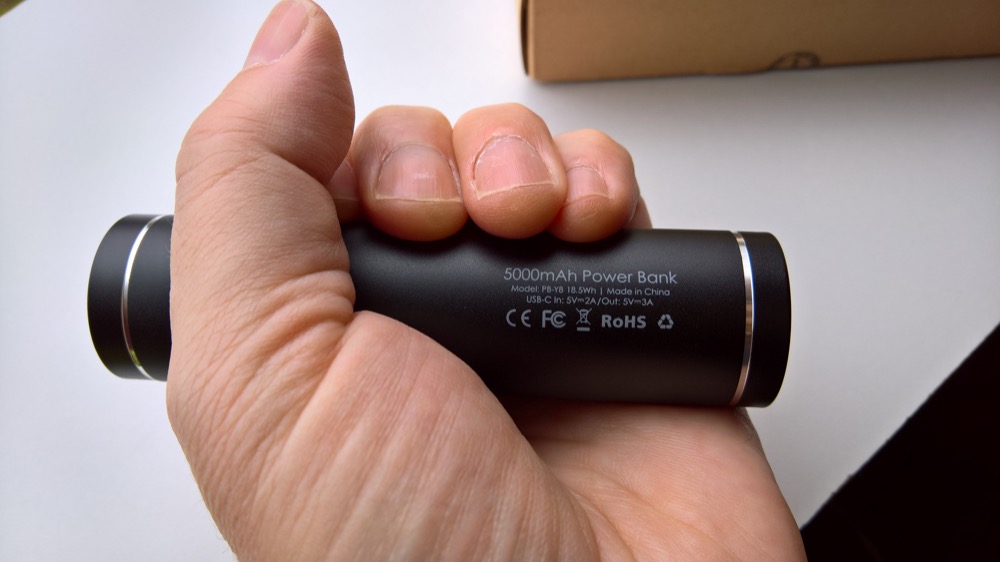Review: AUKEY Type C Power Bank - USB-A need not apply!
Score:
78%
What if... the whole world was USB Type C and 'traditional' USB Type A ports had been long forgotten? Seems very premature, even in 2017, yet many of us only now have USB Type C phones, so why not go all-in on Type C (as Apple did with the 2016 Macbook Pro)? What about your power bank?
Buy Link | Download / Information Link
In such a world, even your pocket power bank would be outputting Type C only, it would charge your phone with a C-to-C cable, and it would itself be charged by, you guessed it, Type C. Idyllic or problematic? Actually, a little of both...!
AUKEY specialise in accessories, of course, I reviewed their HALO, more generic, pocket charger here, though it seems not to be sold anymore via my usual sources, oddly. But, in an all Type C world, what about a pocketable power bank, stocked with milliAmp hours, that output only via Type C? It seems that this more futuristic variant of their cylindrical power banks is still a current product, and why not?
I should emphasise at this point that USB Type C can be more complex and powerful than you ever imagined. Apple uses it for their Thunderbolt 3 accessories, it can carry display signals, communications, many manufacturers (including Alcatel) use it for QuickCharge 3.0, while Google and Microsoft stick to so-called 'Power Delivery', up to 4A at 5V, all over the same physical connectors. And, crucially, all of this is - in theory - bidirectional, and I'll come back to this below.

So what we have here is a simple aluminium cylinder, cold metal in the hand, with a single port - USB Type C. You plug a mains charger into this to charge it up in the first place, you plug in a Type C to Type C cable (supplied) to use this gadget to charge up a modern smartphone. Nice and simple.
The specs on the side of the power bank quote a 3A maximum (at 5V), but in practice the most I got, over three charging sessions with three different phones, was 2A 'delivered'. Not that you should read too much into this, since there are significant electrical losses when transferring charge, usually up to 30%. Thus most 2A chargers only really charge phones at about 1.4A 'delivered', i.e. proveably received by the target phone's battery and reported by its OS and UI. Just be aware of this mark down when you spec out power banks for yourself!

There are some gotchas, as you might imagine. The most obvious of which is that when your partner or child says "I need to charge my iPhone or Android phone or Nintendo DS" (or whatever), all you can say is "Sorry, unless you're living in the modern age and have Type C then you're out of luck!" Only more lovingly and gently, hopefully. This is unashamedly for a Type C only world and this needs to be borne in mind when buying.

Secondly, and slightly confusingly, there's that 'Type C is bidirectional' statement above. Given that the standard allows for data and current to go both ways, how do the phone and power bank know which way the charge should flow? I mean, you know and I know what's supposed to happen, but how does the technology know?
'With caution' is the answer, since some of my Windows phones started charging immediately from this AUKEY gadget, while others started charging the power bank. From the phone.
If you think about it, this isn't so unusual for C-to-C connections between equipment from different manufacturers and the trick seems to be to press the single button on the AUKEY charger to get its electronics active. The charge state is shown and the gadget starts looking for thing to charge. Plug in your Windows 10 Mobile phone at that stage and it will charge just fine. What you can't necessarily do is plug in the phone first, since - depending on the exact state the phone is in - the power bank may decide that the presence of power on the wires means that you're trying to charge it!
All of this isn't an issue in the real world, since you should always check that a phone's OS and interface show that charging is taking place before wandering off and leaving it, regardless of platform or hardware. It's just common sense. So, on the couple of occasions where I've plugged in in the wrong 'order', I've spotted immediately that a) there's no charging indication on the battery on the Windows status bar, b) there's no charging 'sound', and c) the charge LEDs are blinking, implying that it think it's being charged.
A wonderful futuristic design and facility? Maybe. It does generally work as advertised, and £13 doesn't seem too unreasonable for such a nice piece of metallic accessory. But the USB Type C standard doesn't seem as intelligent as we'd all hoped it might be and surely the electronics should be able to work out that it's a million times more likely that you'd want to charge the phone from the power bank than the other way around!!
Reviewed by Steve Litchfield at
